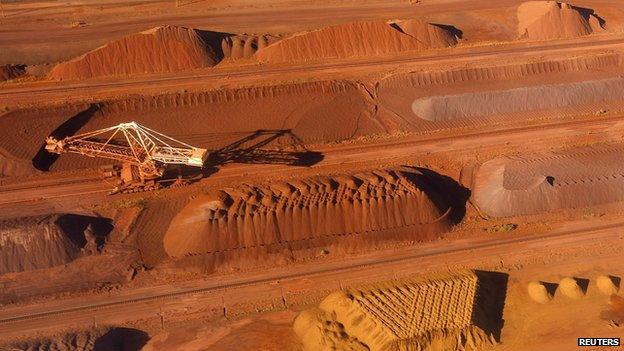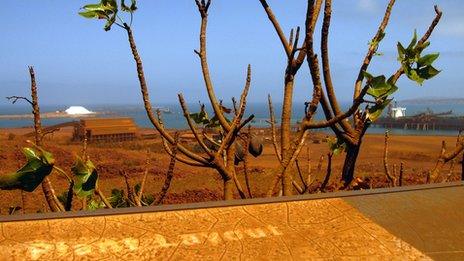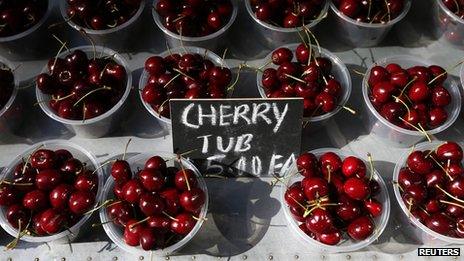Viewpoint: How has the boom changed Western Australia?
- Published

The mining and resources boom has fuelled the Australian economy - but how has it changed Western Australia, asks Professor Fiona Haslam McKenzie.
While other Western economies have languished or even faced bankruptcy, the Australian economy has, for the last decade, experienced exponential growth on the back of what appears to have been insatiable Asian, most particularly Chinese, demand for our mineral resources.
Iron ore, most of which is produced in Western Australia, has been the stand-out resource. For most of the last 10 years, Chinese steel mills have been prepared to pay almost anything for it.
The growth statistics are extraordinary:
The value of Western Australia's iron-ore exports to China have increased more than ninefold, from A$5bn ($4.5bn, £2.9bn) in 2001 to $46bn in 2012
Western Australia accounts for about one quarter of global iron-ore production
Exports from the Pilbara region - which contains the major ports at Karratha and Port Hedland - alone are valued at $63bn - and growing
Iron ore is currently Western Australia's highest earning export worth 52% of total merchandise exports
Not for the first time, some Western Australians, including the premier of the state, claim that the rest of Australia is riding on Western Australia's economic coattails.

Since the 1960s, when the federal government removed the restrictions on the international sale of iron ore, there have been several resource booms.
Western Australia has gone from being the isolated, poor little-sister state with a modest economy at best to what t'other siders (Australians living in the eastern states) refer to as the brash, greedy sister.
Earlier this year, Federal Treasurer Wayne Swan announced in his May budget that Western Australia's share of the Goods and Service Tax (GST) would be 45.5 cents for every dollar earned.
The GST is a value-added tax of 10% on most goods and services, which is purportedly refunded back to the states based on a complicated horizontal fiscal equalisation formula aimed at providing the same level of services to all Australians.
Put simply, Treasury has assessed Western Australia's earnings and largesse to be so much greater than every other state (with the exception of Queensland) that 54.5 cents in every dollar should be redistributed elsewhere.
Influx
So has Western Australia changed because of the mining boom?
Certainly! There are now more people living in Western Australia than ever before, with a 23% increase in population in the last decade.
At the 2011 census, external, Western Australia once again recorded the fastest annual rate of growth in the nation, just as was the case in the previous census in 2006.
The growth is from overseas migration, with about 8,100 people arriving in 2010. The largest group are New Zealanders, while only 1,800 came from interstate.
While many of the newcomers are working on mine sites, it is calculated that for every job on a mine site, five indirect jobs are created in the capital city, Perth.

Iron ore and other minerals are exported from ports in the Pilbara region
In addition, there is a large number of people flying into and out of Western Australia to mine sites, where they stay for block shifts ranging from eight days to 40 days, depending on their roles.
None of these people are recorded in the census. They are usually accommodated in company-owned and administered transient worker housing, often some distance from towns.
It is difficult to know exactly how many long-distance commuting workers there are in Western Australia because the Australian Bureau of Statistics (ABS) does not specifically count transient workers or the long-distance commuter workforce in the five-yearly census.
Nonetheless, this rapid growth in population, industry sectors and communities has not been without growing pains. The impact of the mining boom and the consequent increase in population is straining housing markets and increasing the demand for developable land.
While Western Australians enjoy weekly earnings higher than the Australian average, they also experience one of the highest costs of living in the nation.
A significant proportion of this is due to the high cost of land and housing, which is even higher in those areas where iron ore is mined.
For example, in the Pilbara region, an area of 502,000 sq km (194,000 sq miles) and the epicentre of iron-ore production, the median weekly rent is $1,550 and the cost of living is the highest in the state (137% more than that of Perth).
This is bearable if you are working in a high-paid job, living in accommodation provided by your employer, but for those who are working in retail, service industries, agriculture and tourism, the cost of living is very expensive.

Australia's cost of living is high - but particularly so in Western Australia
The cost of food has also escalated. Areas close to the city that were previously reliable horticultural production land are now prime building locations.
The boom draws into focus potential threats to food security due to diminished local food production and hence local food availability.
Labour competition
The costs of food production and manufacturing generally have been exacerbated by the competition for labour, and as the Australian currency strengthened against international currencies, so the cost of Australian products increased on international markets.
Not surprisingly, then, trade-exposed industries such as agriculture, tourism and manufacturing have languished during the boom.
Much has also been made of newfound wealth for the Aboriginal traditional owners, who have negotiated substantial mining royalty agreements.
The reality is, however, they represent a small proportion of the Western Australian Aboriginal population.
Resource companies have made commitments to increase the number of Aboriginal people employed on the construction and mine sites, as well as preserving some contracts specifically for Aboriginal-owned businesses.
Overall, however, the health, education, employment and well-being indicators for all Western Australian Aboriginal people have changed little over the last 10 years.
For those who are recipients of royalty payments, the agreements ensure that the wealth is invested for the future, focusing on enhancing education and skills attainment for young Aboriginal people in particular and improving the health indicators.
The aggregation of economic and social indicators suggest that Australians and Western Australians in particular have prospered, but closer examination shows that there are "haves" and "have nots" and the gaps are in fact widening, depending upon people's access to the wealth generated by the resources boom.
Most Western Australians who want a job have a job, but not everyone can work, and life for them is difficult.
Certainly growth has been good, but growth does not last forever, and there will need to be careful management of communities and people by government and community leaders for the inevitable social and economic pains which come with a leavening of expectations and income.
As demand for steel in China begins to temper, perhaps that time has come.
Professor Fiona Haslam McKenzie is a professorial fellow at Western Australia's Curtin Graduate School of Business and principal research leader at the Co-operative Research Centre - Remote Economic Participation.